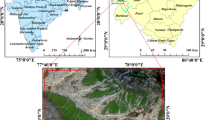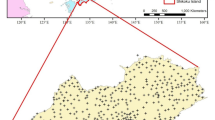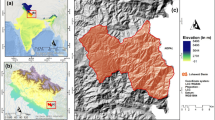Abstract
There is a growing interest in investigating the accuracy of digital elevation model (DEM). However people usually have an unbalanced view on DEM errors. They emphasize DEM sampling errors, but ignore the impact of DEM resolution and terrian roughness on the accuracy of terrain representation. This research puts forward the concept of DEM terrain representation error (Et) and then investigates the generation, factors, measurement and simulation of DEM terrain representation errors. A multi-resolution and multi-relief comparative approach is used as the major methodology in this research. The experiment reveals a quantitative relationship between the error and the variation of resolution and terrain roughness at a global level. Root mean square error (RMS Et) is regressed against surface profile curvature (V) and DEM resolution (R) at 10 resolution levels. It is found that the RMS Et may be expressed asRMS Et=(0.0061·V+0.0052)·V+0.2415. This result may be very useful in forecasting DEM accuracy, as well as in determining the DEM resolution related to the accuracy requirement of particular application.
Similar content being viewed by others
References
Li Z. On the measure of digital terrain model accuracy.Photogrammetric Record, 1988,72(12): 873–877.
Li Z. Effect of check points on the reliability of DTM accuracy estimates obtained from experimental tests.Photogrammetric Engineering and Remote Sensing, 1991,57(10): 1333–1340.
Li Z. Mathematical models of the accuracy of digital terrain model surfaces linearly constructed from square gridded data.Photogrammetric Record, 1993,14(82): 661–673.
Fisher P F. First experiments in viewshed uncertainty: the accuracy of the viewshed area.Photogrammetric Engineering and Remote Sensing, 1991,57 (10): 1321–1327.
Carter J R. The effect of data precision on the calculation of slope and aspect using gridded DEM.Cartographica, 1992,29: 22–34.
Bolstad P V, Stowe T. An evaluation of DEM accuracy elevation, slope, and aspect.Photogrammetric Engineering and Remote Sensing, 1994,60(11): 1327–1332.
Garbrecht J, Martz L. Grid size dependency of parameters from digital elevation models.Computer & Geosciences, 1994,20(1): 85–87.
Giles P, Franklin S E. Comparison of derivation topographic surfaces of DEMs generated from stereoscopic SPOT images with field measurements.Photogrammetric Engineering and Remote Sensing, 1996,62(10): 1165–1171.
Veregin H. The effect of vertical error in digital elevation models on the determination of flow-path direction.Cartography and Geographic Information System, 1997,24(2): 67–79.
Gao J. Resolution and accuracy of terrain representation by grid DEMs at a micro-scale.Int. J. Geographical Information Science, 1997,11(2): 199–212.
Gao J. Impact of sampling intervals on the reliability of topographic variables mapped from grid DEMs at a micro-scale.Int. J. Geographical Information Science, 1998,12(8): 875–890.
Cheng K, Tsai B. The effect of DEM resolution on slope and aspect mapping.Cartography and Geographic Information Systems, 1991,18: 69–77.
Burrough P A. Princiles of Geographical Information Systems for Land Resources Assessment, Oxford: Oxford University Press, 1986. 147–166.
Yuan L P. Grid based DEMs accuracy analysis.Survey and Mapping Standardisation, 1989,17(3): 12–19.
Martz L W, Garbrecht J. Numerical definition of drainage network and subcatchment areas from digital elevation models.Computers and Geosciences, 1992,18(6): 747–761.
Monckton C. An investigation into the spatial structure of error in digital elevation data.Innovations in GIS, I. London: Taylor and Francis, 1994. 201–211
Tang G. A Research on the Accuracy of Digital Elevation Models. New York: Science Press, 52–160.
Author information
Authors and Affiliations
Corresponding author
Additional information
Foundation item: National Natural Science Foundation of China, No. 49971065; Open Research Fund Program of LIESMARS, No. WKL99-0302; High-visiting Scholar Fund of the Key Laboratory of Continental Dynamics, Ministry of Education, China
Author: Tang Guo’an (1961-), Ph.D., specialized in DEM accuracy and GIS-based spatial analysis.
Rights and permissions
About this article
Cite this article
Guo-an, T., Strobl, J., Jian-ya, G. et al. Evaluation on the accuracy of digital elevation models. J. Geogr. Sci. 11, 209–216 (2001). https://doi.org/10.1007/BF02888692
Accepted:
Issue Date:
DOI: https://doi.org/10.1007/BF02888692




